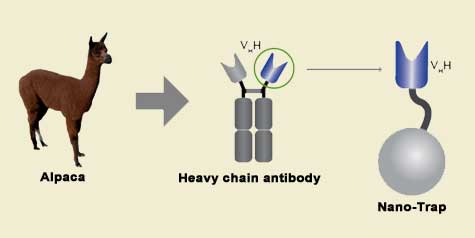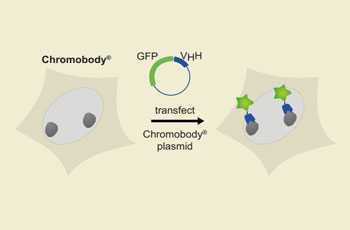Lamin Chromobody Immunodetection Vector
Antibody Detection within Living Cells
A non-invasive way to quantify apoptosis as it happens
The new Lamin Chromobody Immunodetection Vector is a major breakthrough in High Content Analysis (HCA) of apoptosis as other assays rely on static endpoint assays. The nuclear lamina is a scaffolding that encases the entire nucleus and supports the nuclear envelope. Its function is to hold together nuclear content and to add mechanical support to the nucleus. The nuclear lamina helps maintain a balance between structural rigidity and morphological change. As a result, artificial incorporation of overexpressed and fluorescently labeled lamin proteins often lead to undesired cytotoxic side effects. The new Lamin Chromobody overcomes this unwanted side effects.
The small size of the Lamin Chromobody produces a high signal-to-noise ratio for stunning, high resolution images or time lapsed movies of nuclear lamina dynamics. Remarkably, it has no influence on cellular functions and exhibits extremely low toxicity of most cell types. Simply transfect the cell line of your choice with the Lamin Chromobody plasmid. This plasmid contains the sequence of a Lamin-specific alpaca antibody fused to TagGFP2 (Evrogen). Upon transformation, your cells will express the Lamin Chromobody. The periphery of the cell’s nucleus will fluoresce a strong ring-like form as the fluorescent Chromobody molecules specifically localize to the surface of the lamina. This transient binding does not influence cell viability or nuclear-related processes, and thus offers you a unique possibility to monitor the nuclear integrity and morphology during live cell microscopy as an indicator for cellular health and viability. You can also use the Lamin Chromobody as a biosensor for real-time assays of mitosis or apoptosis.
Confocal live cell imaging of cells going through mitosis


HeLa (left) and U2OS (right) cells stably expressing Lamin Chromobody fused to TagGFP2. Cells going through mitosis show the typical rim like structure (in G phase), nuclear lamina depolymerization (in prometaphase) and reassembly at the end of mitosis (in telophase).
Apoptosis Assay with Lamin-Chromobody


Time lapse imaging of untreated cells (left) and after addition of 5 µM staurosporine (STS) (right) using Lamin Chromobody Lamin Chromobody fused to TagGFP2. Note the characteristic “exploding” fragments observed during apoptosis after the cells are treated with STS.
Quantitative evaluation with automated image acquisition and computational pattern recognition. Morphological changes of the lamina (as detected with the Lamin Chromobody) like fragmentation and vesicle formation were monitored in 15 minute intervals. The percentage of apoptotic cells after treatment with increasing concentrations of STS (0-5 µM) over a time of 20h is shown.

Chromobodies turn your cells into immuno-reporter factories
Nanobodies are unique, small antibody fragments that exhibit the extraordinarily efficacious binding of a targeted protein. Expressed in animal cells, Nanobodies can be collected and used for in vitro studies. Something unexpected happened when Nanobodies were expressed as a fusion to a reporter molecule such as GFP. The newly formed Chromobody bound directly to its target within the cells in which it was being made. Moreover, using the correct vector and promoters, the binding has both high specificity and low background. This provides an excellent alternative to GFP-fusions with the protein of interest for immuno-localization studies. Why? Because GFP- and RFP-fusions have been shown to block or alter the activity of the fused protein. In contrast, Chromobody act in trans as a reporter that will not interfere with the normal function of the targeted protein.

Camelidae single-domain antibodies are like IgGs on steroids
The family of animals known as Camelidae (camels, llamas, and alpacas) produce functional antibodies devoid of light chains, so-called "heavy chain" antibodies. These heavy chain antibodies recognize and bind their antigens via a single variable domain. When cleaved from their carboxy tail, these barrel-shaped structures (2x3 nm) are extraordinarily small, naturally-occurring, and intact antigen binding fragments (MW of 13 kDa). These fragments, called Nanobodies, are characterized by high specificity, affinities in the low nanomolar range, and dissociation constants in the sub-nanomolar range (typically 10- to 100-fold better than mouse IgGs). The compact size of Nanobodies makes them extremely stable at temperatures up to 70°C, and functional even in 2M NaCl or 0.5% SDS. These small and powerful antibody fragments can be used in a variety of unique applications. They will open up your research possibilities.
Lamin Chromobody Immunodetection Vector
|
SPECIFICATIONS
|
|
|---|---|
| Part Numbers | LCBGFP, lcg, lcr |
| Vector Type | Mammalian expression vector encoding the cell cycle marker Lamin-VHH fused to green fluorescent protein TagGFP2 |
| Target Molecule | Nuclear lamina |
| Reporter | TagGFP2 (from Evrogen) |
| Host Cells | Mammalian |
| Transfection Method | Transfect mammalian cells by any known transfection method. If required, stable transformants can be selected using G418 [Gorman 1985] |
| Propagation in E. coli | DH5alpha, HB101, XL1-Blue, and other general purpose strains
Incompatible with pMB1/ColE1 |
| Selection | Prokaryotic – kanamycin
Eukaryotic – neomycin (G418) |
| Replication | Prokaryotic – pUC ori
Eukaryotic – SV40 ori |
| Use | Non-invasive live cell visualization of the nuclear lamina during the cell cycle |


